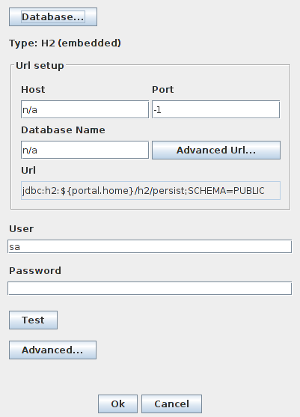Appboard/old/configuration database: Difference between revisions
imported>Jason.nicholls No edit summary |
imported>Jason.nicholls No edit summary |
||
| Line 2: | Line 2: | ||
[[Category:AppBoard old]] | [[Category:AppBoard old]] | ||
__TOC__ | __TOC__ | ||
== Overview == | |||
A default installation of AppBoard / enPortal will use an in-memory H2 database that runs within the same process as the main application. This is the easiest and most convenient configuration but in clustered and/or high availability environments it may be necessary to configure an external shared database. | A default installation of AppBoard / enPortal will use an in-memory H2 database that runs within the same process as the main application. This is the easiest and most convenient configuration but in clustered and/or high availability environments it may be necessary to configure an external shared database. | ||
Revision as of 06:37, 18 July 2014
Overview
A default installation of AppBoard / enPortal will use an in-memory H2 database that runs within the same process as the main application. This is the easiest and most convenient configuration but in clustered and/or high availability environments it may be necessary to configure an external shared database.
The configuration database is used to store a variety of system configuration:
- enPortal users
- enPortal channel configuration
- enPortal Single Sign-on tokens
- AppBoard (versions 2.3 or later) Stacks, Boards, Widgets, filter rules, etc...
This database is only used for configuration data and the resource requirements are very minimal if using an external database.
Using an External Config DB
enPortal / AppBoard includes a utility to set up and configure an external configuration database. Please note this assumes the appropriate JDBC driver is installed, and you have an external database to connect to along with access credentials:
- Open a terminal and change into the [INSTALL_HOME]/server/bin directory and run:
- > portal dbsetup
- This will launch a graphical user interface to assist with the configuration as shown to the right.
- Use the Database button to select from a list of pre-configured templates, such as MySQL.
- Adjust the Host and Port fields to match the database host and port. After making a database selection the port will default to the default for that database type.
- Set the Database Name field to match the name of the database created to store the AppBoard configuration data.
- Set the User and Password used to authenticate against the database.
- Click the Test button to establish a connection and ensure the details are correct.
- The Advanced Url... button can be used to set specific JDBC connection parameters.
- The Advanced... button can be used to configure some additional connection management settings.
- Click the Ok button to save changes and exit the tool.
Creating an External Config DB
In cases where an external database is not already available it will be necessary to install and create one specifically for AppBoard. The following guides are examples only - please refer to the actual database product documentation for complete documentation.
In addition, once the database has been created, it will be necessary to run through the Using an External Config DB section to configure AppBoard to use it.

